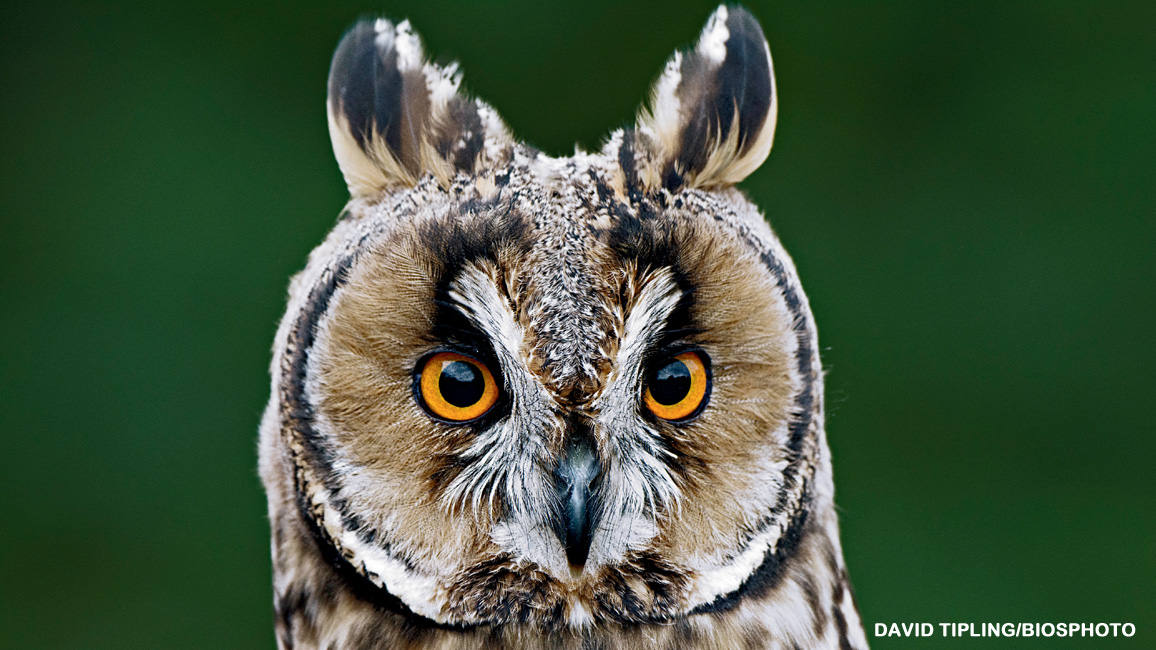
Whoo’s Whoo?
By Ellen LambethHere’s an extremely closeup look at eight owls you might see—or hear—somewhere near you. Get the full picture on each one.


SNOWY OWL
If you’re a Harry Potter fan, you’ll recognize this Hedwig lookalike right away. This large, mostly white owl lives from east to west all across North America, but only in the way-northern part of the continent. On rare occasions, snowy owls travel southward into the United States in search of more winter food. And if you’re very lucky, you may see one! Some years, one even visits the nation’s capital. The song of a snowy owl is a loud, gruff hoot.
GREAT HORNED OWL
It’s “great” because it’s big—and a fierce hunter. And it’s “horned” because it has tufts of feathers on its head that look like horns. You can find great horned owls just about anywhere across the country—in any habitat (maybe including your own backyard) and at any time of the year. And in true owl fashion, they actually say “WHO.”
BARN OWL
Sure, barn owls often roost (rest) in barns. But barns aren’t everywhere, so any good hiding space will do. Some people even put up nest boxes for barn owls, since there aren’t nearly as many of the owls as there once were. They live throughout the country except the far northern part. It’s easy to recognize a barn owl by its heart-shaped white face. And its cry in the night sounds like a screaming banshee. Yikes!
SCREECH OWL
Depending on where you live, you might have eastern or western screech-owls nearby. They look a lot alike, and their feathers might be mostly gray, brown, or rust-colored. But despite their names, neither really screeches. The one shown here is an eastern screech owl. Its song is like a horse whinnying or a loud trill—sometimes both. The western screech-owl sounds like a tooting horn. With its ear tufts, a screech-owl looks a little like a mini great horned owl.

GREAT GRAY OWL
You probably won’t get a chance to see this owl unless you’re in the high pine forests of the northwestern states. Great grays are more common in the Far North, including on the other side of the globe. Like the great horned and snowy owls, the great gray is big. Those other owls may be heavier, but the great gray is taller.
LONG-EARED OWL
As you can guess by its name, this owl has “ear tufts” even longer than a great horned owl’s “horns.” Long-eared owls are very worldly birds. You can find them across North America, Eurasia, and even parts of Africa. They aren’t big owls, but they look fairly long and lean compared to other owls. Their song is a very classic “HOOT!”
BARRED OWL
Be sure not to confuse “barred” with “barn.” Like the barn owl, the barred owl has brown, not yellow, eyes. The barred owl’s white breast feathers have streaks of brown, and its brown back feathers have bars of white. Barred owls are mostly found in woodlands of the eastern half of the country but have now spread into the Pacific Northwest and parts of California. Their main claim to fame is their awesome song. It sounds like someone yelling, “Who cooks for you? Who cooks for you all?”
NORTHERN SAW-WHET OWL
Saw-whets are roly-poly, robin-sized owls that appear to be all head. They live all across the country, but migrate from place to place at certain times of the year. The
strange name comes from their call. Some people thought it sounded like a saw being sharpened on a whetstone. Saw-whets are common in woodlands. But even if they’re in your area, you’re far more likely to hear one than see one.
Want to find out whooo might be in your own neck of the woods? Check out these owl-prowling tips!
Rangers: We thank the Macaulay Library at the Cornell Lab of Ornithology for the owl songs provided here.

















